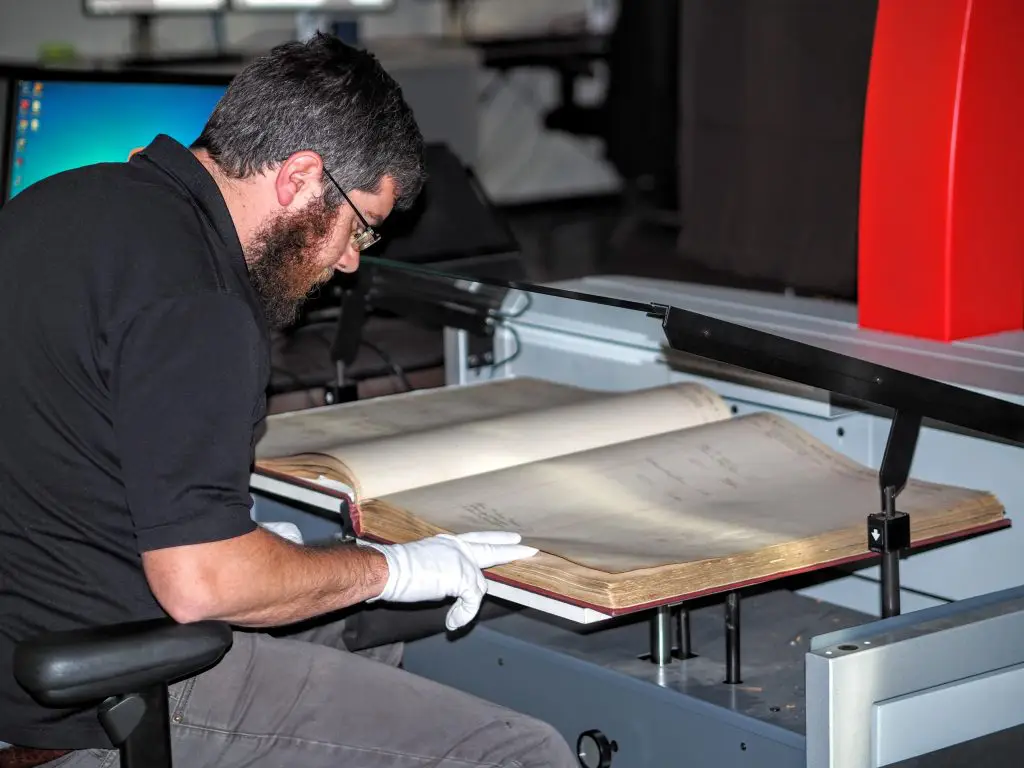What the FADGI %*#&!? Part Three: Selecting Equipment to Achieve FADGI Compliance


To aid in my own understanding, I recruited the expertise of Crowley’s in-house technical guru on all things FADGI, Corin van de Griek. Corin is Crowley’s technical lead in the field of color science and has worked closely with federal archivists in several government agencies to fully understand current FADGI standards.
Star Ratings
“First you have to understand that FADGI-compliance is not a naked eye issue and it’s not a resolution issue,” says Corin. “It’s not about clicking on the highest DPI or PPI option in your software menu. It’s about optimizing each piece of the system and then integrating them into a whole. Each star rating is a set of complex mathematical standards; to achieve those levels of performance not only must each part function well, they must function well with each other.”
As a quick reminder, FADGI compliance is measured at levels of one to four stars, with four stars as the most demanding.
“To meet a star rating, images must consistently meet the resolution requirement (ie: 600 DPI) at 85% or better,” tutors Corin. “Higher stars mean slower throughput due to the need for daily target scans, equipment calibrations and having to rescan images with minute drifts that would be easily accepted on a non-compliant project.”
When asked to describe how the star system might be applied to materials to be digitized, Corin gave this “very general” outline:
Used for content and images frequently accessed
Used for content and context. In the case of a document, this might include the ability to note – from the digitized image – paper condition, paper weave, age, ink type and other attributes critical to researchers
Used as an effective surrogate for the original (ie: fine arts) and in cases in which the original should no longer be handled, touched, transported, etc. unless absolutely necessary
Achieving Stars
The star rating requirements are pretty black and white, notes Corin. The real challenge, he says, lies in finding equipment that can meet the complex FADGI measurements consistently and maintain their performance over time. There also must be an understanding that, particularly with bound book and document scanning, production throughput will take a back seat to meeting the requirements.
Calibration
Imaging targets are the foundation of the FADGI toolbox, used to evaluate, diagnose and calibrate every aspect of the image workflow. The scanners and cameras utilized must not only have the pixel density needed, but be paired with the right lenses and lighting to meet the aggressive standards. Corin emphasizes that these conditions are unlikely to be found in an off-the-shelf or non-production camera or scanner but rather belong to more specialized capture hardware.

Workflow
Corin presses the point that once the equipment is calibrated, the work isn’t done. Every factor must be considered in a FADGI-oriented workflow. Environmental elements such as room lighting, climate control and even the operator’s clothing can all impact the project in different ways. Understanding how the camera/scanner behaves over time is critical as well; it’s important to know how frequently a scanner or camera will need to be recalibrated to maintain the expected quality. Taking these elements into consideration will help to ensure that the project comes out with superior images and on a reasonable deadline.
Expertise
As he talks, Corin underscores that experience always makes the difference. Cultivating camera and scanner operators and project leads who understand the details of their equipment and how they interact with the FADGI standards is, he believes, vital to long-term success. Operators should have a thorough understanding of the required image standards and the kinds of processing that have been deemed acceptable within the scope of a given project. Operator experience can help to avoid simple errors that would fail otherwise acceptable scans in a FADGI test.
Equipment Recommendations

Corin recommends that those needing FADGI-compliant images ask for digitized samples from their own source material before either purchasing or leasing a scanner or outsourcing digitization services to meet FADGI requirements. In his words, “Show me the target.”
While there are other brands available that meet FADGI standards, Crowley Imaging has had success with the following:
- Zeutschel OS 14000 overhead and large format book and document scanner (achieves up to three stars with four on the horizon)
- Mekel Technology MACH-Series microfilm scanners (the MACH 5, 10 and 12 can each achieve up to three stars; the series has not yet been tested at four stars)
- Digital Transitions 100MP Digital Back cameras for graphic art digitization (achieves up to four stars)
- MACHCAM 71MP camera (verified two- star performance in experimental conditions)
“I obviously come at this a little one-sided,” says Corin. “As a manufacturer and distributor with its own technical support departments, as well as one of the largest imaging services divisions in the nation, Crowley is in a unique position to approach FADGI from all sides. We know what it takes to build and operate a FADGI-compliant scanner or camera, what it takes to coax a scanner or camera into compliance and the value of experienced imaging professionals who are well-seasoned. From a personal standpoint, I have all the equipment and source material that I need close at hand to test and achieve FADGI standards where possible. I know this is not the case for everyone, so hopefully what I’ve learned can shed some light on the topic for someone else. ”
Learn more about Crowley’s digitization solutions
For more information on the FADGI-compliant digitization imaging services and hardware offered by The Crowley Company, please visit our website or call (240) 215-0224. General inquiries can be emailed to [email protected]. You can also follow The Crowley Company on Facebook, Twitter, Google+, LinkedIn, Pinterest and YouTube.

